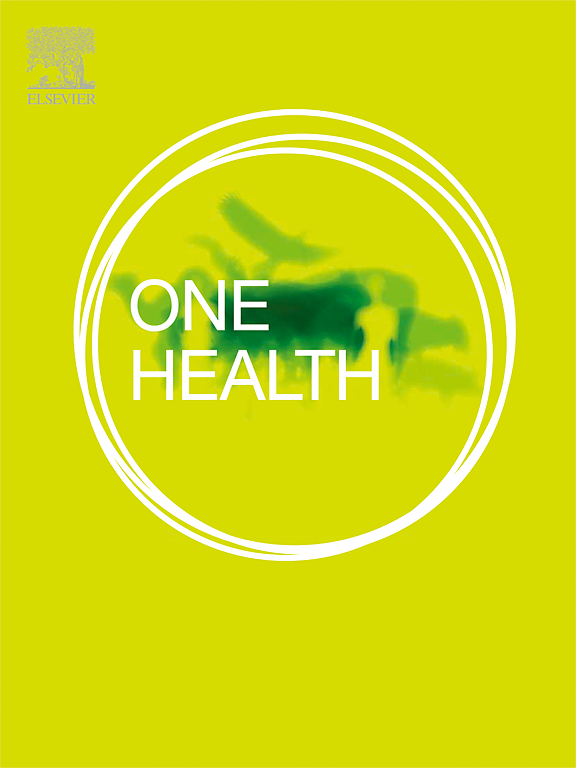Systematic review and meta-analysis of Campylobacter species infections in humans and food-producing animals in Nigeria, 2002-2023: The imperative of a One Health control approach
IF 4.1
2区 医学
Q1 INFECTIOUS DISEASES
引用次数: 0
Abstract
Zoonotic Campylobacter species (ZCS), particularly C. jejuni, C. coli, and C. lari, pose significant health risks to humans and food-producing animals (FPAs). This study investigates the prevalence, geospatial and temporal distributions of Campylobacter species infections (CSI) in Nigeria from 2002 to 2023 through a systematic review and meta-analysis of 40 studies, adhering to PRISMA 2020 guidelines. The overall pooled prevalence of CSI was 33 % (95 % CI: 25 % - 41 %), with significant variations among hosts: poultry (42 %, 95 % CI: 27 % - 57 %), humans (30 %, 95 % CI: 23 % - 38 %), and cattle (21 %, 95 % CI: 15 % - 32 %). In humans, the prevalence were 20.3 % in healthy individuals, 23.8 % in diarrheic patients, and 34.2 % in HIV patients. C. coli was the predominant isolate in humans (87.5 %) and cattle (38.1 %), while C. jejuni was prevalent in poultry (76.2 %). The North-West geopolitical zone exhibited the highest geospatial prevalence at 40 % (95 % CI: 23 % - 57 %). Meta-regression analysis indicated that diagnostic method did not significantly impact prevalence (p = 0.2170), but sample type explained 25.70 % of the between-study variance (Wald χ2 (2) = 33.10, p < 0.0001). Poultry samples showed the highest predicted prevalence at 47.8 % (95 % CI: 39.01 % - 56.51 %), significantly greater than cattle at 18.3 % (95 % CI: 8.9 % - 27.8 %; coefficient = 0.2942, p < 0.001). Sensitivity analyses showed minimal changes in pooled prevalence (33 % to 32 %), confirming the robustness of findings despite high heterogeneity (I2 = 99.48 % vs. 99.52 %). Temporal analysis indicated that poultry infections peaked between 2016 and 2020. These findings highlight the critical importance of implementing effective biosecurity measures and enhancing food safety practices to mitigate Campylobacter transmission in Nigeria, particularly in poultry and the North-West zone, which exhibited the highest prevalence rates. The adoption of One Health control approach, including the “farm to fork” principle, is strongly recommended to limit human Campylobacter infections by ensuring comprehensive food safety practices throughout the livestock production and processing value chains.
人畜共患病弯曲杆菌(ZCS),尤其是空肠弯曲杆菌、大肠弯曲杆菌和拉氏弯曲杆菌,对人类和食用动物(FPA)的健康构成重大风险。本研究遵循 PRISMA 2020 指南,通过对 40 项研究进行系统回顾和荟萃分析,调查了 2002 年至 2023 年期间尼日利亚弯曲杆菌感染 (CSI) 的流行率、地理空间和时间分布情况。CSI的总体汇总流行率为33%(95% CI:25% - 41%),不同宿主之间存在显著差异:家禽(42%,95% CI:27% - 57%)、人类(30%,95% CI:23% - 38%)和牛(21%,95% CI:15% - 32%)。在人类中,健康人的感染率为 20.3%,腹泻患者为 23.8%,艾滋病患者为 34.2%。大肠杆菌是人类(87.5%)和牛(38.1%)中最主要的分离菌,而空肠大肠杆菌在家禽中最常见(76.2%)。西北地缘政治区的地域流行率最高,为 40%(95% CI:23% - 57%)。元回归分析表明,诊断方法对流行率没有显著影响(p = 0.2170),但样本类型解释了 25.70 % 的研究间差异(Wald χ2 (2) = 33.10, p < 0.0001)。家禽样本的预测流行率最高,为 47.8 %(95 % CI:39.01 % - 56.51 %),明显高于牛样本的 18.3 %(95 % CI:8.9 % - 27.8 %;系数 = 0.2942,p < 0.001)。敏感性分析表明,尽管异质性很高(I2 = 99.48 % vs. 99.52 %),但汇总流行率的变化很小(33 % 到 32 %),这证实了研究结果的稳健性。时间分析表明,家禽感染在 2016 年至 2020 年间达到高峰。这些发现凸显了在尼日利亚实施有效的生物安全措施和加强食品安全操作以减少弯曲杆菌传播的极端重要性,尤其是在家禽和西北地区,因为这两个地区的感染率最高。强烈建议采用 "统一健康 "控制方法,包括 "从农场到餐桌 "原则,通过确保整个畜牧业生产和加工价值链中的全面食品安全操作来限制人类感染弯曲杆菌。
本文章由计算机程序翻译,如有差异,请以英文原文为准。
求助全文
约1分钟内获得全文
求助全文
来源期刊

One Health
Medicine-Infectious Diseases
CiteScore
8.10
自引率
4.00%
发文量
95
审稿时长
18 weeks
期刊介绍:
One Health - a Gold Open Access journal.
The mission of One Health is to provide a platform for rapid communication of high quality scientific knowledge on inter- and intra-species pathogen transmission, bringing together leading experts in virology, bacteriology, parasitology, mycology, vectors and vector-borne diseases, tropical health, veterinary sciences, pathology, immunology, food safety, mathematical modelling, epidemiology, public health research and emergency preparedness. As a Gold Open Access journal, a fee is payable on acceptance of the paper. Please see the Guide for Authors for more information.
Submissions to the following categories are welcome:
Virology,
Bacteriology,
Parasitology,
Mycology,
Vectors and vector-borne diseases,
Co-infections and co-morbidities,
Disease spatial surveillance,
Modelling,
Tropical Health,
Discovery,
Ecosystem Health,
Public Health.
 求助内容:
求助内容: 应助结果提醒方式:
应助结果提醒方式:


